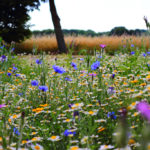Starting around 2006, we began seeing a large amount of media coverage surrounding the problem of reduced populations in managed honey bee populations, called Colony Collapse Disorder (or CCD). This disorder is characterized by the loss of large portion of the worker bees in a colony or loss of the colony entirely. Until recently, this disorder mainly affected worker bees, but is beginning to affect queens as well.

CCD has been a particularly difficult issue to diagnose and combat, mainly because the factors causing it cannot be definitively confirmed or denied. To make matters worse, each of the likely causes have a number of variables that affect them as well.
Historically, bee colonies experience a loss of approximately 17% of the population every year naturally over winter, but the recent winters have taken between 20 and 40% of each colony.
There are several “likely suspects” that may be contributing to CCD:
Varroa mites
Varroa mites (Varroa destructor) are suspected to have migrated to the United States sometime in the 80’s. They are a blood-leeching parasite that attach themselves to honeybees and drink their blood. These mites can spread between colonies and can kill entire populations if not controlled. However, it is difficult to attribute large scale die-offs to varroa mites because there is a treatment to combat them.
Agricultural pesticides
Without a doubt, this potential contributor to CCD has received the most media attention and scrutiny, and is a logical place to look to while searching for causes of CCD. Pesticides are still hotly debated as being a source of CCD, but some evidence has been found that links a family of pesticides called neonictinoids to reduced immune function in honey bees and the inability to find their way back to the hive. Reduced immune response makes honey bees more susceptible to disease and infection, which in turn effects the health of the colony.
While the research into neonicotinoids show that it does affect honey bees’ immune systems, other research has shown that levels of pesticides are not high enough to contribute to widespread exposure or harm to honey bees. After all, exposing bees to high levels of a chemical in a lab is not the same thing as the “diluted” amounts found in a farm field.
Poor nutrition
This possible cause has a great number of contributing factors, including weather, urbanization and temperatures. Considering the fact that there are more green lawns now than ever before in human history, it’s no wonder that honey bee populations are in decline. Just as humans need a varied, balanced diet to maintain optimal health, so do honey bees need a variety of pollens. With natural prairies dwindling, it’s becoming ever more difficult for honey bees to find a diverse and plentiful source of pollen to stay healthy.
Whether blistering hot or frigidly cold, extreme weather puts stress on colonies as well. A particularly cold winter can kill off more of a colony’s population that a milder one. Hot summers can affect not only the bees themselves, but can damage the plants that bees rely on for food. How about a drought or excessive rainfall? Both effect plant life in a way that it eventually recovers from, but this could also affect the food supply of bee colonies.
Bee keepers to give their colonies pollen supplements as a short-term fix, but the destruction of natural habitat and environmental impacts remain at the beginning of the chain of problems affecting honey bee nutrition.
 The problem is so big, what can I do?? Well yes, this seems to be a big problem but we can all help! Each of us is a small piece in a very large puzzle.
The problem is so big, what can I do?? Well yes, this seems to be a big problem but we can all help! Each of us is a small piece in a very large puzzle.
If you have a large property, consider reducing the amount of manicured lawn you maintain and establishing a natural prairie. Not only will you be spending less time mowing your lawn, you will be giving yourself something beautiful to look at and providing honey bees with a source of pollen. Don’t forget, less lawn means lower fertilizing costs!
If you don’t have the space to establish a prairie, consider planting flowering plants in your plant beds in lieu of non-flowering ones. Large drifts of native flowers are beautiful and easy to maintain, and there are varieties that also feed birds. Adding color for every season doesn’t hurt either; it gives you something beautiful to look at year-round and provides bees with year-round sources of food.

